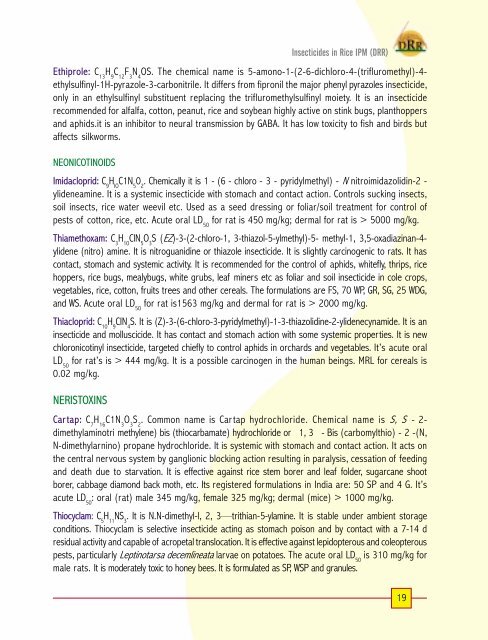priciples of insecticide use in rice ipm
priciples of insecticide use in rice ipm
priciples of insecticide use in rice ipm
You also want an ePaper? Increase the reach of your titles
YUMPU automatically turns print PDFs into web optimized ePapers that Google loves.
Insecticides <strong>in</strong> Rice IPM (DRR)<br />
Ethiprole: C 13 H 9 C 12 F 3 N 4 OS. The chemical name is 5-amono-1-(2-6-dichloro-4-(trifluromethyl)-4ethylsulf<strong>in</strong>yl-1H-pyrazole-3-carbonitrile.<br />
It differs from fipronil the major phenyl pyrazoles <strong><strong>in</strong>secticide</strong>,<br />
only <strong>in</strong> an ethylsulf<strong>in</strong>yl substituent replac<strong>in</strong>g the trifluromethylsulf<strong>in</strong>yl moiety. It is an <strong><strong>in</strong>secticide</strong><br />
recommended for alfalfa, cotton, peanut, <strong>rice</strong> and soybean highly active on st<strong>in</strong>k bugs, planthoppers<br />
and aphids.it is an <strong>in</strong>hibitor to neural transmission by GABA. It has low toxicity to fish and birds but<br />
affects silkworms.<br />
NEONICOTINOIDS<br />
Imidacloprid: C H C1N 0 . Chemically it is 1 - (6 - chloro - 3 - pyridylmethyl) - N nitroimidazolid<strong>in</strong>-2 -<br />
9 IO 5 2<br />
ylideneam<strong>in</strong>e. It is a systemic <strong><strong>in</strong>secticide</strong> with stomach and contact action. Controls suck<strong>in</strong>g <strong>in</strong>sects,<br />
soil <strong>in</strong>sects, <strong>rice</strong> water weevil etc. Used as a seed dress<strong>in</strong>g or foliar/soil treatment for control <strong>of</strong><br />
pests <strong>of</strong> cotton, <strong>rice</strong>, etc. Acute oral LD for rat is 450 mg/kg; dermal for rat is > 5000 mg/kg.<br />
50<br />
Thiamethoxam: C H ClN O S (EZ)-3-(2-chloro-1, 3-thiazol-5-ylmethyl)-5- methyl-1, 3,5-oxadiaz<strong>in</strong>an-4-<br />
3 10 5 3<br />
ylidene (nitro) am<strong>in</strong>e. It is nitroguanid<strong>in</strong>e or thiazole <strong><strong>in</strong>secticide</strong>. It is slightly carc<strong>in</strong>ogenic to rats. It has<br />
contact, stomach and systemic activity. It is recommended for the control <strong>of</strong> aphids, whitefly, thrips, <strong>rice</strong><br />
hoppers, <strong>rice</strong> bugs, mealybugs, white grubs, leaf m<strong>in</strong>ers etc as foliar and soil <strong><strong>in</strong>secticide</strong> <strong>in</strong> cole crops,<br />
vegetables, <strong>rice</strong>, cotton, fruits trees and other cereals. The formulations are FS, 70 WP, GR, SG, 25 WDG,<br />
and WS. Acute oral LD for rat is1563 mg/kg and dermal for rat is > 2000 mg/kg.<br />
50<br />
Thiacloprid: C H CIN S. It is (Z)-3-(6-chloro-3-pyridylmethyl)-1-3-thiazolid<strong>in</strong>e-2-ylidenecynamide. It is an<br />
10 9 4<br />
<strong><strong>in</strong>secticide</strong> and molluscicide. It has contact and stomach action with some systemic properties. It is new<br />
chloronicot<strong>in</strong>yl <strong><strong>in</strong>secticide</strong>, targeted chiefly to control aphids <strong>in</strong> orchards and vegetables. It’s acute oral<br />
LD for rat’s is > 444 mg/kg. It is a possible carc<strong>in</strong>ogen <strong>in</strong> the human be<strong>in</strong>gs. MRL for cereals is<br />
50<br />
0.02 mg/kg.<br />
NERISTOXINS<br />
Cartap: C 7 H 16 C1N 3 O 3 S 2 . Common name is Cartap hydrochloride. Chemical name is S, S - 2dimethylam<strong>in</strong>otri<br />
methylene) bis (thiocarbamate) hydrochloride or 1, 3 - Bis (carbomylthio) - 2 -(N,<br />
N-dimethylarn<strong>in</strong>o) propane hydrochloride. It is systemic with stomach and contact action. It acts on<br />
the central nervous system by ganglionic block<strong>in</strong>g action result<strong>in</strong>g <strong>in</strong> paralysis, cessation <strong>of</strong> feed<strong>in</strong>g<br />
and death due to starvation. It is effective aga<strong>in</strong>st <strong>rice</strong> stem borer and leaf folder, sugarcane shoot<br />
borer, cabbage diamond back moth, etc. Its registered formulations <strong>in</strong> India are: 50 SP and 4 G. It’s<br />
acute LD 50 : oral (rat) male 345 mg/kg, female 325 mg/kg; dermal (mice) > 1000 mg/kg.<br />
Thiocyclam: C 5 H 11 NS 3 . It is N.N-dimethyl-l, 2, 3—trithian-5-ylam<strong>in</strong>e. It is stable under ambient storage<br />
conditions. Thiocyclam is selective <strong><strong>in</strong>secticide</strong> act<strong>in</strong>g as stomach poison and by contact with a 7-14 d<br />
residual activity and capable <strong>of</strong> acropetal translocation. It is effective aga<strong>in</strong>st lepidopterous and coleopterous<br />
pests, particularly Lept<strong>in</strong>otarsa deceml<strong>in</strong>eata larvae on potatoes. The acute oral LD 50 is 310 mg/kg for<br />
male rats. It is moderately toxic to honey bees. It is formulated as SP, WSP and granules.<br />
19











